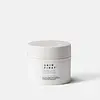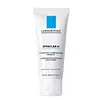What's inside
What's inside
 Key Ingredients
Key Ingredients

 Benefits
Benefits

 Concerns
Concerns

 Ingredients Side-by-side
Ingredients Side-by-side

Water
Skin ConditioningGlycerin
HumectantMethyl Glucose Sesquistearate
EmollientHamamelis Virginiana Leaf Water
AstringentPanthenol
Skin ConditioningGlycol
HumectantSimmondsia Chinensis Seed Oil
EmollientPropylheptyl Caprylate
EmollientArctium Lappa Root Extract
Skin ConditioningFomes Officinalis Extract
Skin ProtectingCucumis Sativus Fruit Extract
EmollientOrbignya Oleifera Seed Oil
EmollientMacadamia Ternifolia Seed Oil
EmollientGlycoproteins
Skin ConditioningGlutamic Acid
HumectantButyrospermum Parkii Butter
Skin ConditioningCetyl Alcohol
EmollientSodium Hyaluronate
HumectantValine
MaskingThreonine
Tocopheryl Acetate
AntioxidantAluminum Starch Octenylsuccinate
AbsorbentAcrylates/C10-30 Alkyl Acrylate Crosspolymer
Emulsion StabilisingAllantoin
Skin ConditioningXanthan Gum
EmulsifyingLecithin
EmollientTocopherol
AntioxidantAscorbyl Palmitate
AntioxidantAmmonium Acryloyldimethyltaurate/Vp Copolymer
Phenoxyethanol
PreservativeEthylhexylglycerin
Skin ConditioningSodium Dehydroacetate
PreservativeSodium Metabisulfite
AntioxidantSodium Benzoate
MaskingPotassium Sorbate
PreservativeTetrasodium Glutamate Diacetate
Citric Acid
BufferingParfum
MaskingCI 42090
Cosmetic ColorantWater, Glycerin, Methyl Glucose Sesquistearate, Hamamelis Virginiana Leaf Water, Panthenol, Glycol, Simmondsia Chinensis Seed Oil, Propylheptyl Caprylate, Arctium Lappa Root Extract, Fomes Officinalis Extract, Cucumis Sativus Fruit Extract, Orbignya Oleifera Seed Oil, Macadamia Ternifolia Seed Oil, Glycoproteins, Glutamic Acid, Butyrospermum Parkii Butter, Cetyl Alcohol, Sodium Hyaluronate, Valine, Threonine, Tocopheryl Acetate, Aluminum Starch Octenylsuccinate, Acrylates/C10-30 Alkyl Acrylate Crosspolymer, Allantoin, Xanthan Gum, Lecithin, Tocopherol, Ascorbyl Palmitate, Ammonium Acryloyldimethyltaurate/Vp Copolymer, Phenoxyethanol, Ethylhexylglycerin, Sodium Dehydroacetate, Sodium Metabisulfite, Sodium Benzoate, Potassium Sorbate, Tetrasodium Glutamate Diacetate, Citric Acid, Parfum, CI 42090
Water
Skin ConditioningDimethicone
EmollientGlycerin
HumectantPropylene Glycol
HumectantEthylhexyl Palmitate
EmollientSqualane
EmollientNiacinamide
SmoothingCaprylic/Capric Triglyceride
MaskingButyrospermum Parkii Butter
Skin ConditioningPEG-100 Stearate
Glyceryl Stearate
EmollientPEG-20 Stearate
EmulsifyingCarbomer
Emulsion StabilisingTriethanolamine
BufferingDimethicone/Vinyl Dimethicone Crosspolymer
Skin ConditioningMyristyl Malate Phosphonic Acid
Skin ConditioningAmmonium Polyacryloyldimethyl Taurate
Emulsion StabilisingHydroxypalmitoyl Sphinganine
Skin ConditioningCaprylyl Glycol
EmollientTetrasodium EDTA
Xanthan Gum
EmulsifyingCetyl Alcohol
EmollientTocopherol
AntioxidantPhenoxyethanol
PreservativeParfum
MaskingWater, Dimethicone, Glycerin, Propylene Glycol, Ethylhexyl Palmitate, Squalane, Niacinamide, Caprylic/Capric Triglyceride, Butyrospermum Parkii Butter, PEG-100 Stearate, Glyceryl Stearate, PEG-20 Stearate, Carbomer, Triethanolamine, Dimethicone/Vinyl Dimethicone Crosspolymer, Myristyl Malate Phosphonic Acid, Ammonium Polyacryloyldimethyl Taurate, Hydroxypalmitoyl Sphinganine, Caprylyl Glycol, Tetrasodium EDTA, Xanthan Gum, Cetyl Alcohol, Tocopherol, Phenoxyethanol, Parfum
 Reviews
Reviews

Ingredients Explained
These ingredients are found in both products.
Ingredients higher up in an ingredient list are typically present in a larger amount.
This ingredient is also known as shea butter. It is an effective skin hydrator and emollient.
Emollients help soothe and soften your skin. It does this by creating a protective film on your skin. This barrier helps trap moisture and keeps your skin hydrated. Emollients may be effective at treating dry or itchy skin.
Shea butter is rich in antioxidants. Antioxidants help fight free-radicals, or molecules that may harm the body. It is also full of fatty acids including stearic acid and linoleic acid. These acids help replenish the skin and keep skin moisturized.
While Shea Butter has an SPF rating of about 3-4, it is not a sunscreen replacement.
Shea butter may not be fungal acne safe. We recommend speaking with a professional if you have any concerns.
Learn more about Butyrospermum Parkii ButterCetyl Alcohol is a fatty alcohol. Fatty Alcohols are most often used as an emollient or to thicken a product.
Its main roles are:
Though it has "alcohol" in the name, it is not related to denatured alcohol or ethyl alcohol.
The FDA allows products labeled "alcohol-free" to have fatty alcohols.
Learn more about Cetyl AlcoholGlycerin is already naturally found in your skin. It helps moisturize and protect your skin.
A study from 2016 found glycerin to be more effective as a humectant than AHAs and hyaluronic acid.
As a humectant, it helps the skin stay hydrated by pulling moisture to your skin. The low molecular weight of glycerin allows it to pull moisture into the deeper layers of your skin.
Hydrated skin improves your skin barrier; Your skin barrier helps protect against irritants and bacteria.
Glycerin has also been found to have antimicrobial and antiviral properties. Due to these properties, glycerin is often used in wound and burn treatments.
In cosmetics, glycerin is usually derived from plants such as soybean or palm. However, it can also be sourced from animals, such as tallow or animal fat.
This ingredient is organic, colorless, odorless, and non-toxic.
Glycerin is the name for this ingredient in American English. British English uses Glycerol/Glycerine.
Learn more about GlycerinParfum is a catch-all term for an ingredient or more that is used to give a scent to products.
Also called "fragrance", this ingredient can be a blend of hundreds of chemicals or plant oils. This means every product with "fragrance" or "parfum" in the ingredients list is a different mixture.
For instance, Habanolide is a proprietary trade name for a specific aroma chemical. When used as a fragrance ingredient in cosmetics, most aroma chemicals fall under the broad labeling category of “FRAGRANCE” or “PARFUM” according to EU and US regulations.
The term 'parfum' or 'fragrance' is not regulated in many countries. In many cases, it is up to the brand to define this term.
For instance, many brands choose to label themselves as "fragrance-free" because they are not using synthetic fragrances. However, their products may still contain ingredients such as essential oils that are considered a fragrance by INCI standards.
One example is Calendula flower extract. Calendula is an essential oil that still imparts a scent or 'fragrance'.
Depending on the blend, the ingredients in the mixture can cause allergies and sensitivities on the skin. Some ingredients that are known EU allergens include linalool and citronellol.
Parfum can also be used to mask or cover an unpleasant scent.
The bottom line is: not all fragrances/parfum/ingredients are created equally. If you are worried about fragrances, we recommend taking a closer look at an ingredient. And of course, we always recommend speaking with a professional.
Learn more about ParfumPhenoxyethanol is a preservative that has germicide, antimicrobial, and aromatic properties. Studies show that phenoxyethanol can prevent microbial growth. By itself, it has a scent that is similar to that of a rose.
It's often used in formulations along with Caprylyl Glycol to preserve the shelf life of products.
Tocopherol (also known as Vitamin E) is a common antioxidant used to help protect the skin from free-radicals and strengthen the skin barrier. It's also fat soluble - this means our skin is great at absorbing it.
Vitamin E also helps keep your natural skin lipids healthy. Your lipid skin barrier naturally consists of lipids, ceramides, and fatty acids. Vitamin E offers extra protection for your skin’s lipid barrier, keeping your skin healthy and nourished.
Another benefit is a bit of UV protection. Vitamin E helps reduce the damage caused by UVB rays. (It should not replace your sunscreen). Combining it with Vitamin C can decrease sunburned cells and hyperpigmentation after UV exposure.
You might have noticed Vitamin E + C often paired together. This is because it is great at stabilizing Vitamin C. Using the two together helps increase the effectiveness of both ingredients.
There are often claims that Vitamin E can reduce/prevent scarring, but these claims haven't been confirmed by scientific research.
Learn more about TocopherolWater. It's the most common cosmetic ingredient of all. You'll usually see it at the top of ingredient lists, meaning that it makes up the largest part of the product.
So why is it so popular? Water most often acts as a solvent - this means that it helps dissolve other ingredients into the formulation.
You'll also recognize water as that liquid we all need to stay alive. If you see this, drink a glass of water. Stay hydrated!
Learn more about WaterXanthan gum is used as a stabilizer and thickener within cosmetic products. It helps give products a sticky, thick feeling - preventing them from being too runny.
On the technical side of things, xanthan gum is a polysaccharide - a combination consisting of multiple sugar molecules bonded together.
Xanthan gum is a pretty common and great ingredient. It is a natural, non-toxic, non-irritating ingredient that is also commonly used in food products.
Learn more about Xanthan Gum